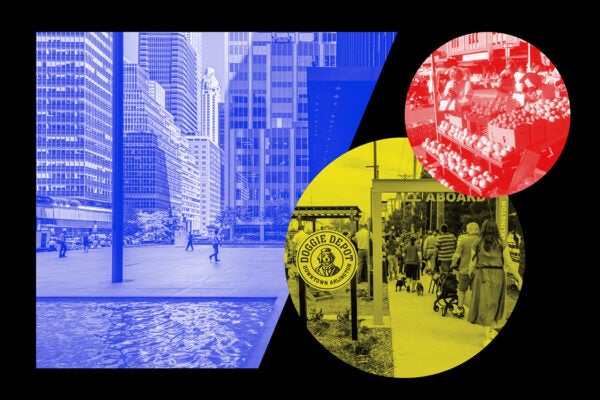University labs and classrooms have been among the greatest transmitters of human knowledge—and error—in history. On the one hand, the theory of general relativity, the computer, the internet, the universal declaration of human rights, and many other world-changing ideas were born in, and have been taught through, our universities. On the other, scientific racism and eugenics, sexist psychological and evolutionary “research” about the supposed innate inferiority of women, sophisticated justifications of and defenses for barbaric colonialism, numerous inaccurate medical theories (that plagues were caused by bad air and not germs, for instance), and that the Big Bang never happened were also imparted as unquestioned gospel to generations of students. These misconceptions went on to contribute to unnecessary social and political ills as well as to human misunderstanding and untold suffering.
Put differently, our universities can be places that amplify both truth and falsehood, both light and darkness. This is why it’s especially important for scholars and educators, including me, to be mindful that while we may be right about many things, we also may be wrong.
The idea that we might be wrong, a concept known as “intellectual humility” that JSTOR Daily has so eloquently been describing of late, is key if we want to embrace the same open-mindedness that initially led us to exploration in the first place. It’s vital if we hope to model appropriate and community-enhancing behavior for our students and not to inadvertently pass on misinformation.
I teach argumentation at UCLA, and I realized early on that if I didn’t invest in my own intellectual humility—and didn’t model it—I’d do both myself and my students a grave disservice. If I’m unwilling to examine and admit things about which I’ve been wrong before, entertain the possibility that I might be wrong about some things now, and be open to being persuaded by others’ ideas (even in my area of expertise), I’d be a know-it-all, sending students the message that being an expert means being dogmatic about your beliefs.
Of course, the true definition of being expert is allowing your scientifically held beliefs to be subject to change in the face of new evidence, new information, and even new lived experience. What has resulted from my intellectual humility? For one, I’ve been liberated from the dangerous idea that being a great scholar and superb educator requires being right all the time. Secondly, I’ve had the invaluable opportunity to see my students experience the same revelation. They report that they learn more, grow more, and are more motivated to intrinsically value the material and their education because they have freed themselves of the mindset and expectation that in order to excel, they must be right.
Practical pedagogical steps to foster an intellectually humble environment:
1. Practice and model intellectual humility.
In our line of knowledge work, we are facing increasing doubts and opposition to what we research and teach, which should make us inherently more circumspect. For example, not only is there a broad public attack on expertise, but there is a replication crisis in science, where potentially up to 70 percent of researchers are unable to replicate the experiments of other scholars, causing many people (and students) to doubt what we have to say. This alone should make us more cautious in how we present ourselves, our findings, and science more generally for both substantive reasons (i.e., not everything we might be saying is right) and perception management reasons (i.e., acknowledging this will break down the stereotype, and sometimes reality, that our profession is arrogant). Although this might seem like taking this approach is a defensive posture, it actually benefits us: Harvard studies show that there are upsides to articulating publicly that we might be wrong on a given topic or in how we interpret reality, as people will counterintuitively see us as more persuasive, humble, and be more open to listening to what we have to say.
A good place for us to start practicing this is by examining a few of the 150 or so potential cognitive biases that we as human beings may possess regardless of education level. Some of the best hidden logical fallacies inherent in our cognitive biases might include the “Dunning-Kruger Effect” (where because we have deep knowledge of some things we believe we are qualified to speak intelligently on most things); “Reactive-Devaluation” (where we dismiss an idea if we don’t respect the source of the idea and don’t dismiss the same idea if we do respect the source); and “The Curse of Knowledge” (where, because we have so much knowledge, we find it difficult to make our knowledge accessible to non-experts). By examining these biases, as well as investing more generally in greater self-awareness, we can start to see some of the factors holding us back from being maximally intellectually humble as well as some of the ways our mental processes—in addition to assumptions, interpretations, and conclusions about our accumulated knowledge—can be distorted. Doing this and sharing it with our students will inspire them to behave likewise. As the late psychologist Albert Bandura has taught us, much of behavior is caught and not taught.
2. We can recognize that while we might be experts at one or two things, we are amateurs at thousands of others. For our quality of life to remain where it is, we’re dependent on countless people who are experts in their fields.
For example, a physicist might have an exceptional understanding of relativity but likely doesn’t know how to source and weave cotton to make her own clothes, how best to maintain road surfaces so that they’re drivable and reliable, or how to test for and treat Parkinson’s, and so on. We rely on other people—other specialists in innumerable areas—because we’re at best amateurs or more likely incompetent in most areas in our lives. This fact alone should give us a sense of deep humility because we cannot prosper much less function without others.
3. Acknowledge that our students are superior to us in at least a few things; we should listen to them as they have something to teach us.
I have taught Olympic gymnasts, Hollywood animators and anime design specialists, and many others who have skills I never will. As Howard Gardner showed us so many years ago with multiple intelligences theory, our students come to our classrooms with all kinds of intelligences besides the cognitive variety; they have visual-spatial intelligence, musical intelligence, naturalistic intelligence, kinesthetic intelligence, intrapersonal intelligence, and more, all of which influence how they see the world and what valuable contributions they can make to classroom discussion. We must see ourselves not just as their teachers but also as their students, learning from them in kind.
4. Incorporate more disciplinary perspectives in our classrooms.
I once took a bioethics course taught by a professor of philosophy who anchored it only in his discipline; he failed to incorporate readings or ideas from biologists, anthropologists, sociologists, political scientists, or the great many other scholars and practitioners who inform the field. This neglect caused students to miss out on the best epistemic traditions that could have been summed up in the context of this course; we missed the opportunity to learn holistically about the topic. It’s regrettable that the professor wasn’t more open to including other perspectives. Being open to those with other knowledge areas helps students understand what scholarly traditions have to say about what we teach and helps us better educate ourselves.
5. Be careful not to present opinions as though they are equivalent to scientific research findings or science itself.
One of the critiques teachers face is that we sometimes present personal beliefs and scientific conclusions in the same empathic, declaratory way, making it hard for students to distinguish between the two. They eventually catch on, however, and figure out that some of what we assert is indeed personal opinion; once the semester is over, however, they dismiss the contents of an entire course as having been a teacher’s irrelevant conjecture—including the legitimate science and theories. We should preface ad-libbed or opinionated comments with something like, “I could be wrong about this but…” to signal that we’re demonstrating intellectual humility and not equating opinion with scholarship. As cognitive linguists have shown, we speak around 16,000 words per day; it’s reasonable to assume that most of these have not been filtered or examined through the scientific method.
6. Stop trying to control students’ thought and behavior.
A renowned television producer recently said something startling: “I have given up my need to be right.” Translated: he forfeited his desire to dictate how others live their lives. In the classroom, we want to be sure students act ethically and cause no harm. At the same time, we may overstep our boundaries as educators if we try to police freedom of expression and insist our students use the same phrases and vernacular we do. A brilliant former classmate of mine refused to use the obscure rhetoric our professor demanded; he received a C in the course for that refusal. Students will invariably express themselves in diverse ways; the tenets of intellectual humility encourage us to give them freedom over themselves in our classrooms, especially when we’re not dealing with rote facts, theories, or equations but rather with personal expression. Don’t insist that they parrot your phrasing or locutions to prove their understanding.
7. Present the strongest arguments in your class for both ideas you believe in and for ones with which you disagree.
In an argumentation class, I present the strongest possible arguments for both the side with which I agree as well as for the side that concerns me or with which I disagree, and I do this using the words and arguments that proponents themselves use, not just “my side.” For example, I’m an environmentalist and believe the science that says climate change is real, but I won’t say that those who question the science are “anti-science,” “for environmental destruction,” and so forth; instead, I’ll use the term that skeptics of climate change say about themselves—they call themselves “conservationists”—because it acknowledges their position and framing.
Initially some students find this unusual, but when I show them that, in a political context, most Republicans and Democrats agree on almost 150 of the most-pressing policy issues in America, they come to understand that, in many cases, we really don’t want different things and that it’s our framing of arguments that causes unnecessary conflict, partisanship, and dehumanization. Consider polling on guns, abortion, and, yes, climate change; Republicans and Democrats consistently agree on some of the the details of how to address these issues even though the media portrays them as opposed. According to the literature, it’s the framing or word choice used to address these issues that cause the biggest disagreements. Word choice and framing may dictate whether we think we can find common ground (even though, in reality, we may already be on it). We should therefore be careful in how we present ideas to ensure utmost accuracy.
Weekly Newsletter
8. Empower students to establish ground rules of discussion etiquette, norms, and classroom engagement.
On day one in my classes I usually ask students to work in small groups to describe their ideal class, their ideal professor, what they’d like to learn, how they’d like to learn it, and what behavioral expectations to which they would like to commit. This simple exercise enables students to feel seen, heard, and understood, causing them to want to think, speak, and behave their best knowing that as their teacher, I’m a partner in the learning process and am working to fulfill their expectations. When students feel they have a say in the structure of the class, they’re more invested in their learning as well as in protecting the classroom as a positive learning sanctuary where intellectual humility presides.
9. Give students ample opportunities to discuss topics with each other and problem solve with hands-on applications in class.
The data on student learning in higher education has emphatically spoken: that the old-school lectures we were taught with as students years ago do not work. In fact, lectures account for just 5 percent of students’ learning, according to ample scholarship, while in-class discussions, problem solving, and other active learning techniques offer ways to engage students and improve not only their intrinsic motivation but also their academic performance and long-term content retention. For me, as somebody who likes to talk—I was on the top-ranked speech and debate team in the world in college—this was initially hard for me to accept. But as I started to humble myself and let the science lead me, I changed my approach to classroom pedagogy so that I could deliver what the students came for: a world-class education that challenges them with rigor and allows them to explore their ideas with each other (and me). This model has me serve as a “guide on the side” and not “sage on the stage” and empowers them to use the best of both theoretical and practical models to grow their cognitive abilities and hands-on skill sets. If you play around with how you structure your classroom with more active learning tools, it could do wonders for your students.







